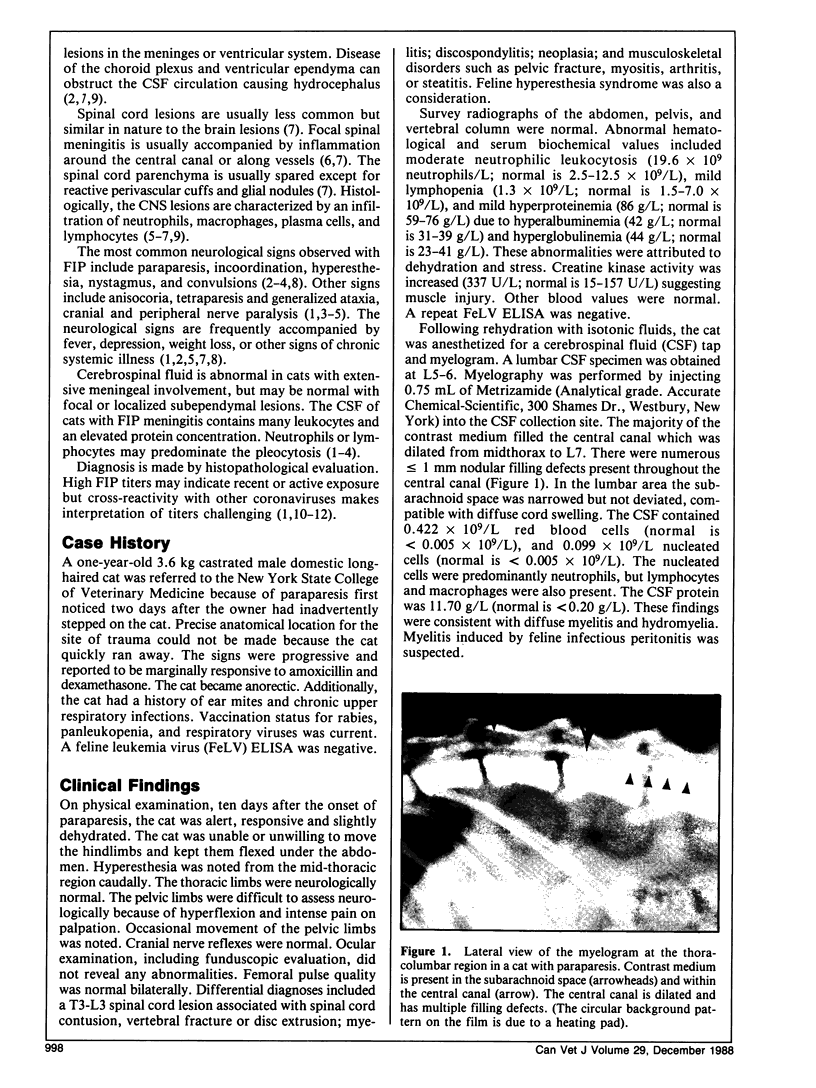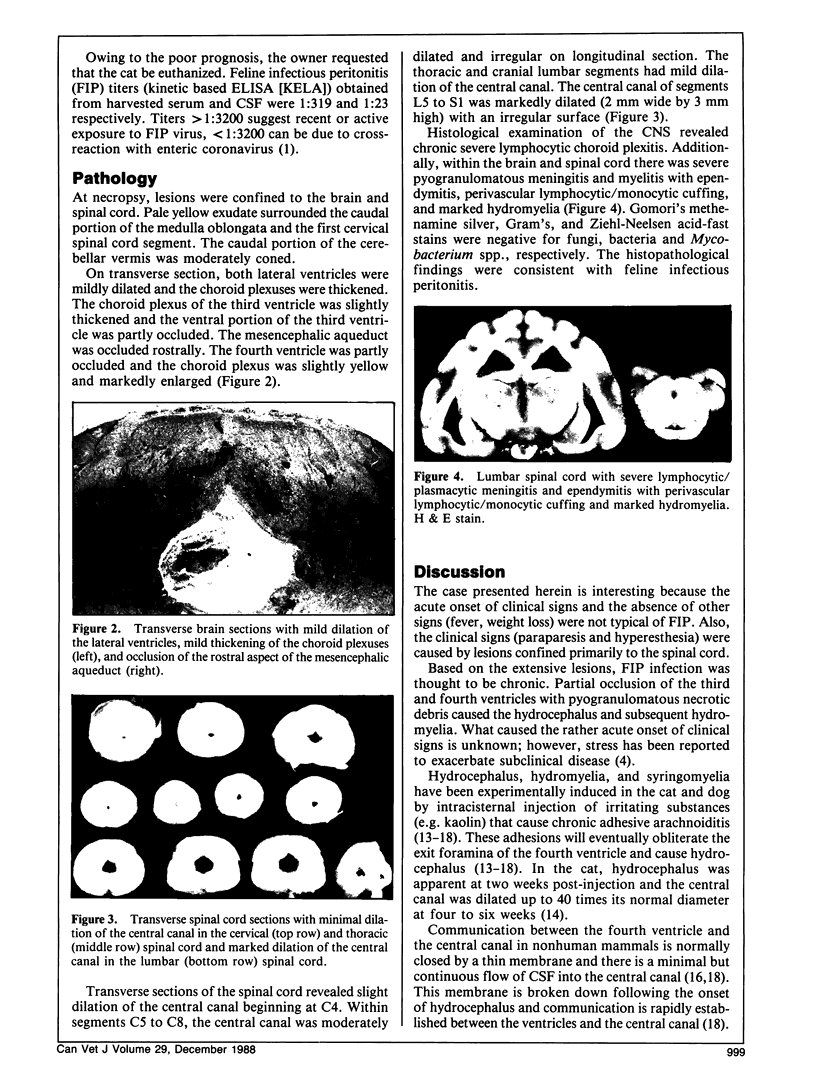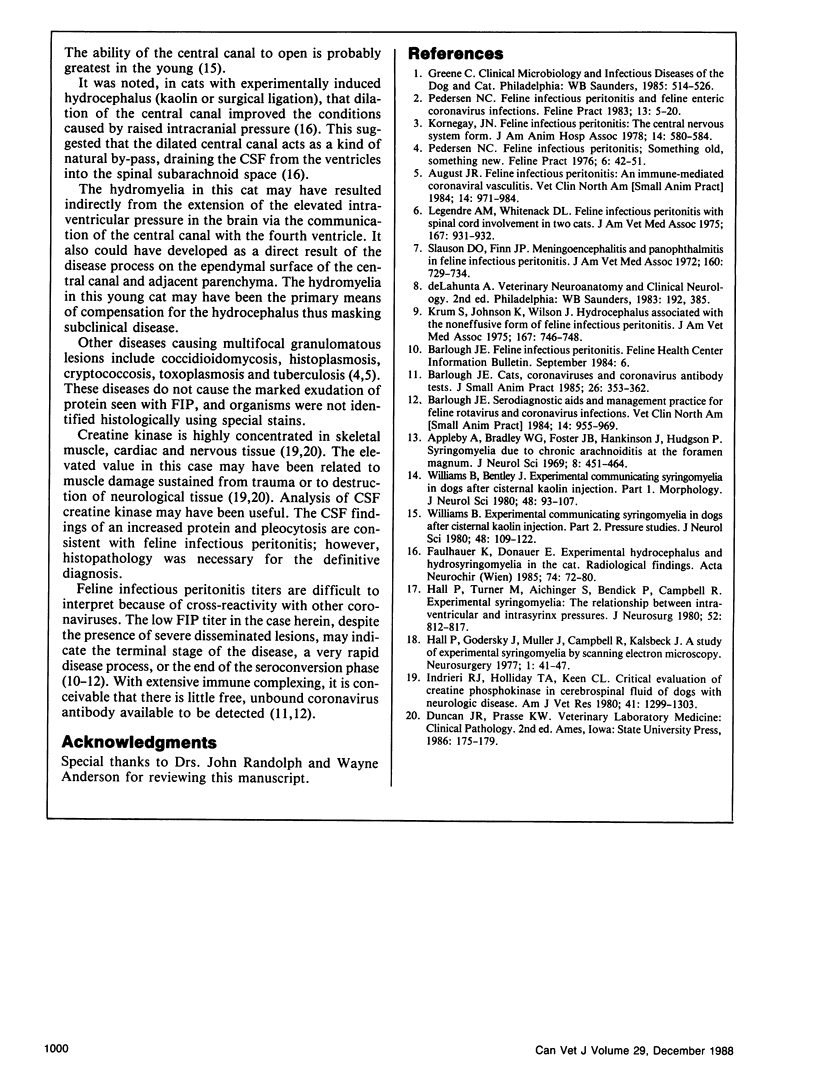Abstract
A one-year-old domestic long-haired cat was referred to the New York State College of Veterinary Medicine because of acute onset of paraparesis and hyperesthesia associated with trauma. Myelography and cerebrospinal fluid analysis revealed severe hydromyelia and myelitis, respectively. The definitive diagnosis of feline infectious peritonitis was made by histological examination at necropsy. Lesions were confined exclusively to the brain and spinal cord. Partial occlusion of the third and fourth ventricles with pyogranulomatous debris caused hydrocephalus and subsequent hydromyelia. The hydromyelia may have been the primary means of compensation for the hydrocephalus, thus masking subclinical disease.
Full text
PDF



Images in this article
Selected References
These references are in PubMed. This may not be the complete list of references from this article.
- Appleby A., Bradley W. G., Foster J. B., Hankinson J., Hudgson P. Syringomyelia due to chronic arachnoiditis at the foramen magnum. J Neurol Sci. 1969 May-Jun;8(3):451–464. doi: 10.1016/0022-510x(69)90005-7. [DOI] [PubMed] [Google Scholar]
- August J. R. Feline infectious peritonitis. An immune-mediated coronaviral vasculitis. Vet Clin North Am Small Anim Pract. 1984 Sep;14(5):971–984. doi: 10.1016/S0195-5616(84)50102-8. [DOI] [PMC free article] [PubMed] [Google Scholar]
- Barlough J. E. Serodiagnostic aids and management practice for feline retrovirus and coronavirus infections. Vet Clin North Am Small Anim Pract. 1984 Sep;14(5):955–969. doi: 10.1016/S0195-5616(84)50101-6. [DOI] [PMC free article] [PubMed] [Google Scholar]
- Faulhauer K., Donauer E. Experimental hydrocephalus and hydrosyringomyelia in the cat. Radiological findings. Acta Neurochir (Wien) 1985;74(1-2):72–80. doi: 10.1007/BF01413282. [DOI] [PubMed] [Google Scholar]
- Hall P., Godersky J., Muller J., Campbell R., Kalsbeck J. A study of experimental syringomyelia by scanning electron microscopy. Neurosurgery. 1977 Jul-Aug;1(1):41–47. doi: 10.1227/00006123-197707000-00009. [DOI] [PubMed] [Google Scholar]
- Hall P., Turner M., Aichinger S., Bendick P., Campbell R. Experimental syringomyelia: the relationship between intraventricular and intrasyrinx pressures. J Neurosurg. 1980 Jun;52(6):812–817. doi: 10.3171/jns.1980.52.6.0812. [DOI] [PubMed] [Google Scholar]
- Indrieri R. J., Holliday T. A., Keen C. L. Critical evaluation of creatine phosphokinase in cerebrospinal fluid of dogs with neurologic disease. Am J Vet Res. 1980 Aug;41(8):1299–1303. [PubMed] [Google Scholar]
- Krum S., Johnson K., Wilson J. Hydrocephalus associated with the noneffusive form of feline infectious peritonitis. J Am Vet Med Assoc. 1975 Oct 15;167(8):746–748. [PubMed] [Google Scholar]
- Slauson D. O., Finn J. P. Meningoencephalitis and panophthalmitis in feline infectious peritonitis. J Am Vet Med Assoc. 1972 Mar 1;160(5):729–734. [PubMed] [Google Scholar]
- Williams B., Bentley J. Experimental communicating syringomyelia in dogs after cisternal kaolin injection. Part 1. Morphology. J Neurol Sci. 1980 Oct;48(1):93–107. doi: 10.1016/0022-510x(80)90153-7. [DOI] [PubMed] [Google Scholar]
- Williams B. Experimental communicating syringomyelia in dogs after cisternal kaolin injection. Part 2. Pressure studies. J Neurol Sci. 1980 Oct;48(1):109–122. doi: 10.1016/0022-510x(80)90154-9. [DOI] [PubMed] [Google Scholar]






